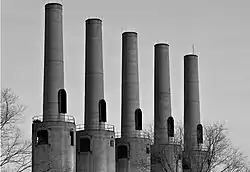Gopher Ordnance Works
Gopher Ordnance Works was a smokeless powder production plant near Coates and Rosemount, Minnesota, United States. It was first opened in 1943. The plant was closed soon after the end of World War II.[1][2] There are some remains still at the original site which is visible from U.S. Route 52 and County Road 46.

| Gopher Ordnance Works | |
|---|---|
 Chimneys at the abandoned plant, photographed in 2010 | |
| General information | |
| Type | Factory |
| Address | Off County Road 46 |
| Town or city | Near Coates and Rosemount, Minnesota |
| Country | United States |
| Coordinates | 44°43′29″N 93°3′14″W |
| Estimated completion | 1943 |
| Closed | 1945 |
| Grounds | 11,000 acres (4,500 ha) |
After the government decided it needed a place to open up another gunpowder factory, they chose Dakota County in East Central Minnesota as their prime spot to put up such a factory, specifically, the city of Rosemount. They soon evicted farmers on 11,000 acres (45 km2) of farmland so that they could build Gopher Ordnance Works, which consisted of 858 buildings.[3][4]
General plant information
Gopher Ordnance could hold approximately 3,000 employees, however, most of the employees were not hired off site and had already worked in the defense industry. The plant was operated by DuPont. The production lines at Gopher were completed in 1943 and idled until 1944 when the government requested the plant begin production and create three additional production lines. The plant began production in January 1945, and was closed in October of the same year. The gunpowder being produced at the plant was being used for navy artillery shells. The smokestacks were for boiling water that was used to manufacture the gunpowder. The large T-Walls were part of solvent recovery houses. The process involved much volatile material.[5]
Environmental impact
The Minnesota Pollution Control Agency inspected the property in 1981 concluding that based on the limited investigation there was no contamination of concern. The U.S. Army Corps of Engineers began inspections in 1985. In 1999, the U.S. Army Corps of Engineers concluded that the property was eligible for restoration funds. In 2005, the Corps revised its position and stated that only the land transferred to the state in 1947 was eligible, and a detailed investigation was completed in March 2009.
In 2010, the University of Minnesota launched a Remedial Investigation to collect information on the environmental condition of the property.[6][7]
Advertising
The plant was unable to get employees easily, so it ran ads in local newspapers. One such ad pictured a woman saying, "If you can run a vacuum cleaner, you can do my war job at Gopher".[5]
References
- "UMore Park : University of Minnesota". www.umorepark.umn.edu. Retrieved 6 April 2017.
- "The Time Line". UMore Park. University of Minnesota. 1 May 2013. Retrieved 6 April 2017.
- "UMore Park History : University of Minnesota". www.umorepark.umn.edu. Retrieved 6 April 2017.
- "Gopher Munitions Plant (aka "The U-Lands")". Action Squad. Retrieved 6 April 2017.
- Dooley, Patricia L. (Summer 1985). "Gopher Ordnance Works: Condemnation, Construction, and Community Response" (PDF). Minnesota History. 49 (6): 214–228. JSTOR 20178926. Retrieved 6 April 2017.
- Peer Engineering (19 August 2003). "Preliminary Environmental Investigation: Former Gopher Ordnance Works, UMore Park, Rosemount, Minnesota" (PDF). UMore Park (Report). University of Minnesota. pp. Appendix A - Background Information. Archived from the original on 11 June 2010. Retrieved 6 April 2017.
- Lauber, John Ford; Gardner, Denis (1 April 2006). "A Historical Interpretation and Preservation Plan for UMore Park" (PDF). UMore Park (Report). Archived from the original (PDF) on 11 June 2010. Retrieved 6 April 2017.
External links
![]() Media related to Gopher Ordnance Works at Wikimedia Commons
Media related to Gopher Ordnance Works at Wikimedia Commons